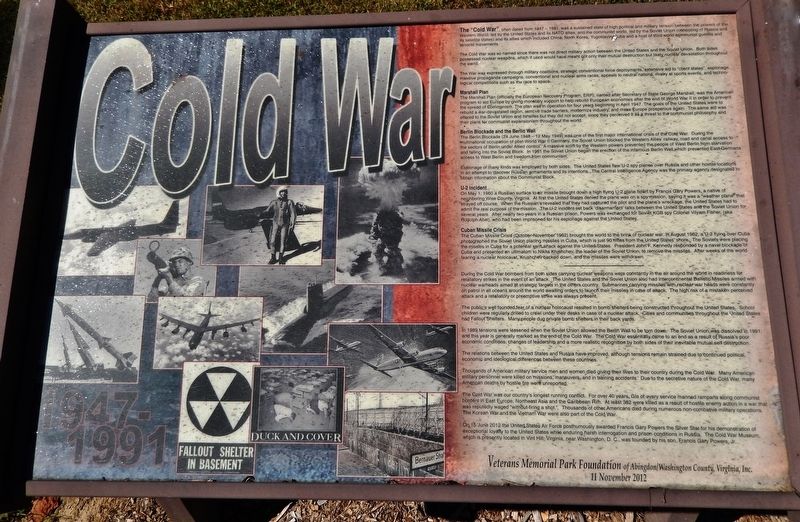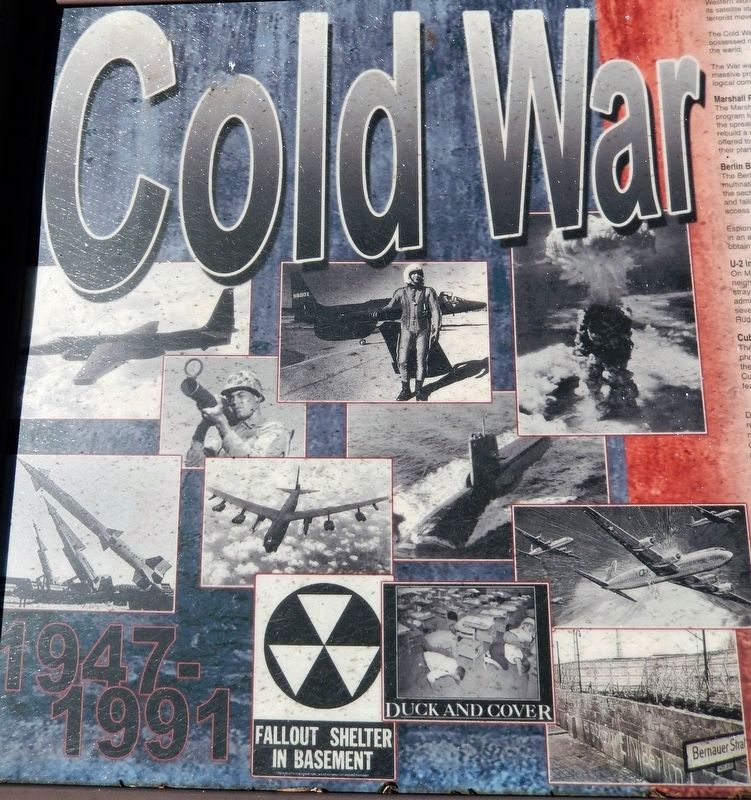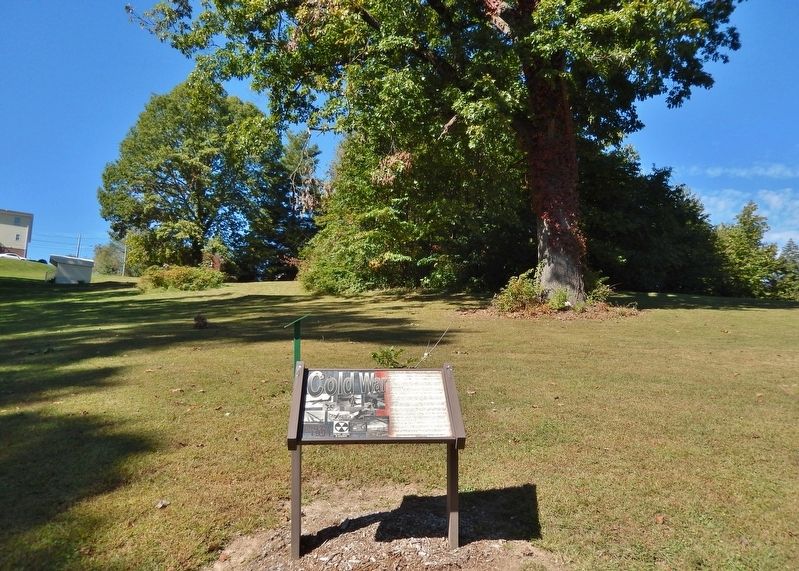Abingdon in Washington County, Virginia — The American South (Mid-Atlantic)
Cold War
1947-1991
The "Cold War”, often dated from 1947-1991, was a sustained state of high political and military tension between the powers of the Western World, led by the United States and its NATO allies, and the communist world, led by the Soviet Union (consisting of Russia and its satellite states) and its allies which included China, North Korea, Yugoslavia, Cuba and a host of third world communist guerilla and terrorist movements.
The Cold War was so named since there was not direct military action between the United States and the Soviet Union. Both sides possessed nuclear weapons, which if used would have meant not only their mutual destruction but likely nuclear devastation throughout the world.
The War was expressed through military coalitions, strategic conventional force deployments, extensive aid to "client states", espionage, massive propaganda campaigns, conventional and nuclear arms races, appeals to neutral nations, rivalry at sports events, and technological competitions such as the race to space.
Marshall Plan
The Marshall Plan (officially the European Recovery Program. ERP), named after Secretary of State George Marshall, was the American program to aid Europe by giving monetary support to help rebuild European economies after the end of World War II in order to prevent the spread of Communism. The plan was in operation for four years beginning in April 1947. The goals of the United States were to rebuild a war-devastated region, remove trade barriers, modernize industry, and make Europe prosperous again. The same aid was offered to the Soviet Union and its allies but they did not accept, since they perceived it as a threat to the communist philosophy and their plans for communist expansionism throughout the world.
Berlin Blockade and the Berlin Wall
The Berlin Blockade (24 June 1948 - 12 May 1949) was one of the first major international crisis of the Cold War. During the multinational occupation of post-World War II Germany, the Soviet Union blocked the Western Allies' railway, road and canal access to the sectors of Berlin under Allied control. A massive airlift by the Western powers prevented the people of West Berlin from starvation and falling into the Soviet Block. In 1961 the Soviet Union begin the erection of the infamous Berlin Wall which prevented East Germans access to West Berlin and freedom from communism.
Espionage of many kinds was employed by both sides. The United States flew U-2 spy planes over Russia and other hostile locations in an attempt to discover Russian armaments and its intentions. The Central Intelligence Agency was the primary agency designated to obtain information about the Communist Block.
U-2 Incident
On May 1, 1960 a Russian surface to air missile brought down a high flying U-2 plane flown by Francis Gary Powers, a native of neighboring Wise County, Virginia. At first the United States denied the plane was on a spy mission, saying it was a "weather plane” that strayed off course. When the Russian's revealed that they had captured the pilot and the plane's wreckage, the United States had to admit the real purpose of the mission. The U-2 incident set back 'disarmament’ talks between the United States and the Soviet Union for several years. After nearly two years in a Russian prison, Powers was exchanged for Soviet KGB spy Colonel Vilyam Fisher, (aka Rudolph Abel), who had been imprisoned for his espionage against the United States.
Cuban Missile Crisis
The Cuban Missile Crisis (October-November 1962) brought the world to the brink of nuclear war. In August 1962, a U-2 flying over Cuba photographed the Soviet Union placing missiles in Cuba, which is just 90 miles from the United States' shore. The Soviets were placing the missiles in Cuba for a potential swift attack against the United States. President John F. Kennedy responded by a naval blockade of Cuba and presented an ultimatum to Nikita Krushchev, the leader of the Soviet Union, to remove the missiles. After weeks of the world fearing a nuclear holocaust, Krushchev backed down and the missiles were withdrawn.
During the Cold War bombers from both sides carrying nuclear weapons were constantly in the air around the world in readiness for retaliatory strikes in the event of an attack. The United States and the Soviet Union also had Intercontinental Ballistic Missiles armed with nuclear warheads aimed at strategic targets in the others country. Submarines carrying missiles with nuclear war heads were constantly on patrol in all oceans around the world awaiting orders to launch their missiles in case of attack. The high risk of a mistaken perceived attack and a retaliatory or preemptive strike was always present.
The public's well-founded fear of a nuclear holocaust resulted in bomb shelters being constructed throughout the United States. School children were regularly drilled to crawl under their desks in case of a nuclear attack. Cities and communities throughout the United States had Fallout Shelters. Many people dug private bomb shelters in their back yards.
In 1989 tensions were lessened when the Soviet Union allowed the Berlin Wall to be torn down. The Soviet Union was dissolved in 1991, and this year is generally marked as the end of the Cold War. The Cold War essentially came to an end as a result of Russia's poor economic conditions, changes of leadership and a more realistic recognition by both sides of their inevitable mutual self-destruction.
The relations between the United States and Russia have improved, although tensions remain strained due to continued political, economic and ideological differences between these countries.
Thousands of American military service men and women died giving their lives to their country during the Cold War. Many American military personnel were killed on missions, maneuvers, and in training accidents. Due to the secretive nature of the Cold War, many American deaths by hostile fire were unreported.
The Cold War was our country's longest running conflict. For over 40 years, GIs of every service manned ramparts along communist borders in East Europe, Northeast Asia and the Caribbean Rim. At least 382 were killed as a result of hostile enemy action in a war that was reputedly waged “without firing a shot.” Thousands of other Americans died during numerous non-combative military operations. The Korean War and the Vietnam War were also part of the Cold War.
On 15 June 2012 the United States Air Force posthumously awarded Francis Gary Powers the Silver Star for his demonstration of exceptional loyalty to the United States while enduring harsh interrogation and prison conditions in Russia. The Cold War Museum, which is presently located in Vint Hill, Virginia, near Washington, D. C., was founded by his son, Francis Gary Powers, Jr.
Erected 2012 by Veterans Memorial Park Foundation of Abingdon/Washington County, Virginia, Inc.
Topics. This historical marker is listed in these topic lists: Air & Space • Patriots & Patriotism • War, Cold. A significant historical year for this entry is 1947.
Location. 36° 42.332′ N, 81° 58.56′ W. Marker is in Abingdon, Virginia, in Washington County. Marker can be reached from Lieutenant Billy Webb Avenue, 0.2 miles north of Cook Street. Marker is located along the Path of Honor in Veterans Memorial Park. Touch for map. Marker is at or near this postal address: 425 Lieutenant Billy Webb Avenue, Abingdon VA 24210, United States of America. Touch for directions.
Other nearby markers. At least 8 other markers are within walking distance of this marker. Poppies (a few steps from this marker); Sons of the American Revolution (a few steps from this marker); Women in Military Service for America (within shouting distance of this marker); History of Veterans Day (within shouting distance of this marker); World War I (within shouting distance of this marker); The War on Terrorism (within shouting distance of this marker); Civil War (within shouting distance of this marker); Medal of Honor (about 300 feet away, measured in a direct line). Touch for a list and map of all markers in Abingdon.
Credits. This page was last revised on February 2, 2023. It was originally submitted on October 18, 2022, by Cosmos Mariner of Cape Canaveral, Florida. This page has been viewed 135 times since then and 18 times this year. Photos: 1, 2, 3. submitted on October 19, 2022, by Cosmos Mariner of Cape Canaveral, Florida.


